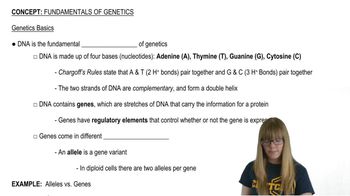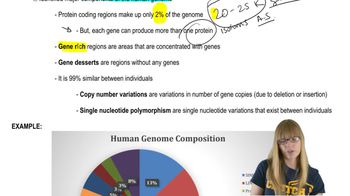Human adult hemoglobin is a tetramer containing two alpha (α) and two beta (β) polypeptide chains. The α gene cluster on chromosome 16 and the β gene cluster on chromosome 11 share amino acid similarities such that 61 of the amino acids of the α-globin polypeptide (141 amino acids long) are shared in identical sequence with the β-globin polypeptide (146 amino acids long). How might one explain the existence of two polypeptides with partially shared function and structure on two different chromosomes?
Table of contents
- 1. Introduction to Genetics51m
- 2. Mendel's Laws of Inheritance3h 37m
- 3. Extensions to Mendelian Inheritance2h 41m
- 4. Genetic Mapping and Linkage2h 28m
- 5. Genetics of Bacteria and Viruses1h 21m
- 6. Chromosomal Variation1h 48m
- 7. DNA and Chromosome Structure56m
- 8. DNA Replication1h 10m
- 9. Mitosis and Meiosis1h 34m
- 10. Transcription1h 0m
- 11. Translation58m
- 12. Gene Regulation in Prokaryotes1h 19m
- 13. Gene Regulation in Eukaryotes44m
- 14. Genetic Control of Development44m
- 15. Genomes and Genomics1h 50m
- 16. Transposable Elements47m
- 17. Mutation, Repair, and Recombination1h 6m
- 18. Molecular Genetic Tools19m
- 19. Cancer Genetics29m
- 20. Quantitative Genetics1h 26m
- 21. Population Genetics50m
- 22. Evolutionary Genetics29m
7. DNA and Chromosome Structure
DNA Structure
Problem 16d
Textbook Question
Which of the following equations are true for the percentages of nucleotides in double-stranded DNA?
(A)/(C)=(G)/(T)
 Verified step by step guidance
Verified step by step guidance1
Understand the structure of double-stranded DNA: DNA is composed of two complementary strands, where adenine (A) pairs with thymine (T) and cytosine (C) pairs with guanine (G). This pairing is governed by Chargaff's rules.
Recall Chargaff's rules: In double-stranded DNA, the amount of adenine (A) is equal to the amount of thymine (T), and the amount of cytosine (C) is equal to the amount of guanine (G). Mathematically, this can be expressed as: and .
Analyze the given equation: The equation provided is . To determine if this equation is true, consider the relationships between the nucleotide pairs.
Apply Chargaff's rules to the equation: Since and , the ratios and are not necessarily equal because the numerator and denominator in each fraction represent different nucleotide pairs.
Conclude based on the analysis: The equation does not align with Chargaff's rules, as the ratios of different nucleotide pairs are not inherently equal in double-stranded DNA.
 Verified video answer for a similar problem:
Verified video answer for a similar problem:This video solution was recommended by our tutors as helpful for the problem above
Video duration:
2mPlay a video:
Was this helpful?
Key Concepts
Here are the essential concepts you must grasp in order to answer the question correctly.
Chargaff's Rules
Chargaff's Rules state that in double-stranded DNA, the amount of adenine (A) is equal to thymine (T), and the amount of cytosine (C) is equal to guanine (G). This means that A pairs with T and C pairs with G, leading to the conclusion that the ratios of these nucleotides are equal in a double helix structure.
Recommended video:
Guided course

Genetics Basics
Base Pairing
Base pairing refers to the specific hydrogen bonding between nucleotides in DNA. Adenine pairs with thymine through two hydrogen bonds, while cytosine pairs with guanine through three hydrogen bonds. This complementary pairing is crucial for the stability of the DNA structure and for accurate DNA replication.
Recommended video:
Guided course

Base Distortions
Nucleotide Composition
The nucleotide composition of DNA refers to the relative amounts of the four nucleotides: adenine, thymine, cytosine, and guanine. In double-stranded DNA, the total percentage of A and T will equal the total percentage of C and G, which is essential for understanding the relationships and ratios among these nucleotides in the context of the question.
Recommended video:
Guided course

Human Genome Composition
Related Videos
Related Practice
Textbook Question
478
views


